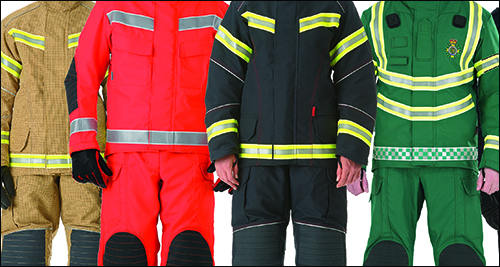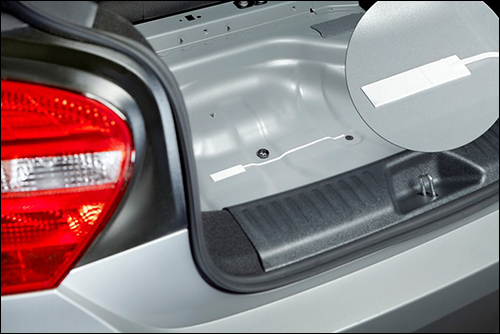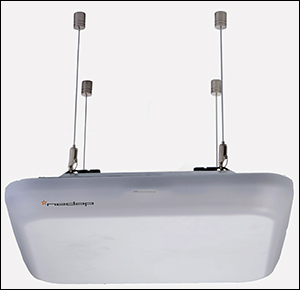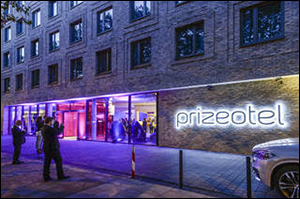Dec 03, 2015The following are news announcements made during the past week by the following organizations:
Bristol Uniforms, Harland Simon;
Smartrac, RFMicron, Turck;
Nedap;
MOCAP Analytics, Zebra Technologies;
Ascom, Ekahau; and
ASSA ABLOY Hospitality.
Bristol Uniforms Chooses Vero RFID Solution from Harland Simon
Bristol Uniforms, a designer and manufacturer of protective clothing for firefighters and other emergency-services personnel, is RFID-tagging its products. The tags will be used to future-proof the garments and prepare for automated tracking of uniforms handled by Bristol's managed services, according to Harland Simon, the tags' supplier.
Bristol Uniforms, which purchased 4,000 passive ultrahigh-frequency (UHF) tags, will sew a tag into the pocket of each newly manufactured uniform item. The waterproof neoprene RFID tags, which are part of Harland Simon's Vero Solutions product line, use the Alien Technology Higgs3 chipset and are designed to withstand temperatures of up to 150 degrees Celsius (302 degrees Fahrenheit), which means it can survive most fire-fighting conditions, as well as professional cleaning procedures, according to the company. Bristol Uniforms operates a managed-care program designed to allow fire and rescue services to rely on the manufacturer to supply a lifetime garment-care process rather than undertake that function in-house. The implementation also includes Zebra Technologies' MC3190-Z series of UHF handheld readers, which are drivers can use to record the collection of uniforms from the fire stations and in the service center for recording inspections and repairs.
The RFID tags are replacing bar-code labels in the uniforms, which are scanned manually upon collection. This is a time-consuming process, according to Harland Simon, as each item must be handled and the bar code located individually. As a manual process, it can also be prone to human error, the company notes.
"Fitting our garments with RFID tags is the first step to automating the tracking of items through our managed care program from collection at the emergency services through washing, inspection and repair cycles right through to return delivery," said Edward Shepherd, Bristol Uniforms' service operations director, in a prepared statement. "Automatic scanning with RFID readers will considerably cut down the time our drivers spent when collecting garments. Multiple items can be scanned simultaneously and without the need to find the bar code. This means they will be able to scan a whole collection bag full of items without even having to take a single one out."
Ultimately, Harland Simon indicates, tracking information will be made available on an online portal in order to provide full visibility for Bristol Uniform's customers to track their garments through each stage of the managed-services process. Full deployment is expected to take place by the end of January 2016.
Smartrac's Sensor Tadpole Tag Can Detect Water Leaks in Cars, Ships, Planes
Smartrac has announced its Sensor Tadpole tag, a passive ultrahigh-frequency (UHF) on-metal tag with a built-in water sensor. According to Smartrac, the tag can be used to ensure that cars leaving its factory are completely watertight, and may also find applications in aviation manufacture and shipbuilding.
The sensor tag features RFMicron's Magnus S2 Sensor IC with its patented Chameleon technology, which can be used to sense moisture or pressure levels. In April 2015, RFMicron announced that a Smartrac tag made with RFMicron's Magnus S moisture-sensing chip was being used by automotive companies to detect whether water penetrates a vehicle's body during high-pressure water tests (see RFMicron Releases New Passive UHF Chips With Moisture, Temperature, Pressure Sensors).
Smartrac's new tag can be deployed on cars during assembly and be used to detect small amounts of water leakage inside vehicle compartments that can damage a car's electronics bays, cabins and trunks. The detection area can be extended by means of a wicking tail, which guides moisture to the sensor tag. This allows even minute amounts of water to be detected quickly, easily and reliably, according to Smartrac, thereby allowing manufacturers to identify the source of a leak. The Sensor Tadpole is deployed in the manufacturing flow as part of an automobile's assembly process, and the tag's antenna transforms environmental data into an impedance change. The tag IC then translates this information into a 5-bit sensor code as it dynamically matches antenna impedance to die impedance.
The tag has a die-cut size of 21.5 millimeters by 73.0 millimeters (0.94 inch by 2.9 inches), is available in white wet (adhesive) singulated format with different tail options, and can be delivered pre-encoded if needed. Furthermore, the unique tag identifier (TID), Electronic Product Code (EPC) and sensor code offer the opportunity to manage and collate the information received from the sensor tag using Smartrac's Smart Cosmos Cloud-based services platform, the company reports, which is of high interest to manufacturers wishing to track the performance of components, or to improve quality management. Suiting all converting-industry needs, Smartrac says, the tag complies with all relevant industry standards and strict quality-control parameters.
The first commercial deployment of the Sensor Tadpole tag is already being piloted, Smartrac reports. A German original equipment manufacturer (OEM) is currently testing the passive sensor tag in high-end cars to ensure that they leave the factory watertight, and the project is being managed by automation partner Turck.
Nedap Unveils Out-of-the-Box Overhead RFID Reader for Discreet Loss Prevention
Nedap has announced the !D Top, a new RAIN RFID overhead reader for electronic article surveillance (EAS). This ceiling-mounted reader has an integrated antenna, takes up no selling space within a store, offers reliable detection and prevents false alarms, with tag filtering and direction detection, the company says.
The reader, which complies with the EPCglobal UHF Gen 2 and ISO 18000-6C specifications, requires no software integration, Nedap adds, so that even if a retailer has not yet implemented RFID technology, store personnel can attach pre-programmed RFID hard tags to the merchandise and use the !D Top for EAS purposes. It requires no floor space, and the overhead reader is designed to blend seamlessly into a store's design and filter out non-moving tags within its direct environment. This makes it possible to place tagged merchandise in the premium selling space near a store's entrance, according to Nedap.
The !D Top is equipped with an antenna array, developed by Nedap, that dynamically creates a multitude of independent beams in various directions. To ensure the best performance (especially the proper balance between detection performance and stray-tag filtering), Nedap says it has built a set of algorithms for direction detection. With this beam-steering functionality, the company explains, the smart integrated reader determines whether a product is actually moving or is just a stationary tag. The functionality also detects the direction in which each RFID label is moving, which makes it possible to reliably monitor whether a person carrying a garment is actually leaving the store or is merely passing underneath the !D Top.
Because the !D Top measure only 15 inches by 15 inches (37 centimeters by 37 centimeters), it is small and light enough to be affixed to a ceiling using a standard VESA mount. It can also be mounted above false ceilings. The device connects to a store's network via an Ethernet connection, but also has a USB socket that serves as a service port. The !D Top can be used standalone as an RFID-based EAS system or as an RFID upgrade to any existing traditional EAS solution.
According to Nedap, the !D Top is available in Europe, the United States, Canada, Asia and the Middle East, and is already being used as an EAS solution in more than 100 stores at various sports and apparel retailers throughout Europe, the United States and Asia. The company says it is unable to name the retailers at this time.
MOCAP, Zebra Team Up on Pro Football Location Tracking, Data Analytics
MOCAP Analytics, a Silicon Valley-based sports-analytics firm, has partnered with Zebra Technologies to work on business opportunities associated with location-tracking and data analytics in the professional and amateur sport of American football.
Zebra has already been working with the National Football League (NFL) and installed its real-time location system (RTLS) for sports at 17 stadiums during the 2014 NFL season (see RFID Drafted to Track NFL Players' Every Move During Games and Best New Product: Zebra's Next-Gen Technology Powers Next-Gen Stats). The deployment has expanded to cover all NFL stadiums for the 2015 NFL season, as part of its Next-Generation Statistics initiative. According to the two companies, the NFL kicked off this season with Zebra's nickel-sized RFID sensors embedded in the shoulder pads of every NFL player.
Mike King, Zebra Sports' director of sports products, reports that MOCAP's data scientists offer expertise in making sense of location-tracking data, using machine learning and artificial intelligence to derive insights regarding players, teams, games and matchups.
"The data collected by Zebra's location-tracking devices has potential to create significant value to coaches, players, trainers, broadcasters, and fans," said Arian Forouhar, MOCAP Analytics' co-founder and CEO, in a prepared statement. "It's exciting to work with an innovator like Zebra and to provide insights to professional and college football teams, focusing on data visualizations and analytics."
Ascom, Ekahau Announce Product Compatibility for Health Care
Ascom's Wireless Solutions division and Ekahau have announced compatibility between their two products: Ascom's Myco smartphone solution and Ekahau's real-time location system (RTLS). With the compatibility, the Myco—a smartphone and information system purpose-built for health care—is now able to provide users with RTLS location-intelligence support. This helps hospitals to enhance patient care and better meet organizational objectives, the two companies report.
Ekahau's proprietary RFID-over-Wi-Fi technology consists of the company's Wi-Fi-based RFID tags, infrared (IR) beacons to make location data more granular and Ekahau's Vision software (which determines the location of a tag worn by an individual or attached to an asset).
Ekahau and Ascom Wireless have worked together in the past to make their products compatible, and these solutions are currently in use at several medical facilities (see RFID News Roundup: Dutch Mental Health-care Provider Uses Ekahau's RTLS to Ensure Staff Safety and St. Andrew's Healthcare Gets Help in Real Time).
Henrik Sandberg, Ascom Wireless Solutions' alliances manager, indicates that the addition of Ekahau RTLS compatibility enhances Ascom Myco's ability to support a wide portfolio of health-care-specific apps and features. "This broad support is really helping to establish the Ascom Myco among caregivers," Sandberg said in a prepared statement. "Alerts, calls, patient data, and now personal alarm with RTLS, almost all the mission-critical data a caregiver might want can be made available on a handset designed to be tough enough for healthcare environments."
German Hotelier Prizeotel Adopts ASSA ABLOY Mobile Access Solution
ASSA ABLOY Hospitality has announced that German hotel chain prizeotel is using the ASSA ABLOY Hospitality Mobile Access system to enhance security and convenience for three of the hotelier's locations in Bremen, Hamburg and Hannover. Mobile Access, which ASSA ABLOY's HID Global division launched in 2014, is designed to let guests use their own smartphones as digital room keys (see RFID News Roundup: HID Global Intros HID Mobile Access, Enabling Smartphone-based Access Control).
Mobile Access allows guests to use a mobile app to obtain a digital key and completely bypass front desk lines upon arriving at the hotel. It works with a hotel's property-management system in order to allocate a guestroom and generate a digital key that is encrypted and securely delivered to the guest's smartphone, and the smartphone places the key in a secure key vault within the mobile app. When the phone is presented to the appropriate lock, the app transmits the encrypted key securely via the phone's Bluetooth Low Energy (BLE) technology, thereby ensuring that only authorized users receive digital key information and gain access. Mobile Access leverages ASSA ABLOY's Seos, which the company launched in 2012 (see ASSA ABLOY Creates NFC Solution that Uses Phones to Open Doors, Grant Computer Access).
At prizeotel, Mobile Access works in conjunction with ASSA ABLOY's VingCard Signature RFID door locks that have also been installed. The VingCard Signature RFID solution requires only a small RFID reader on the door, and Signature RFID is also armed with advanced anti-cloning technology to protect against unauthorized access. The locks work with VingCard Visionline, a patented data-communication platform from ASSA ABLOY Hospitality.
Hotel guests can download the ASSA ABLOY Hospitality Mobile Access app from the Google Play and iTunes websites.





